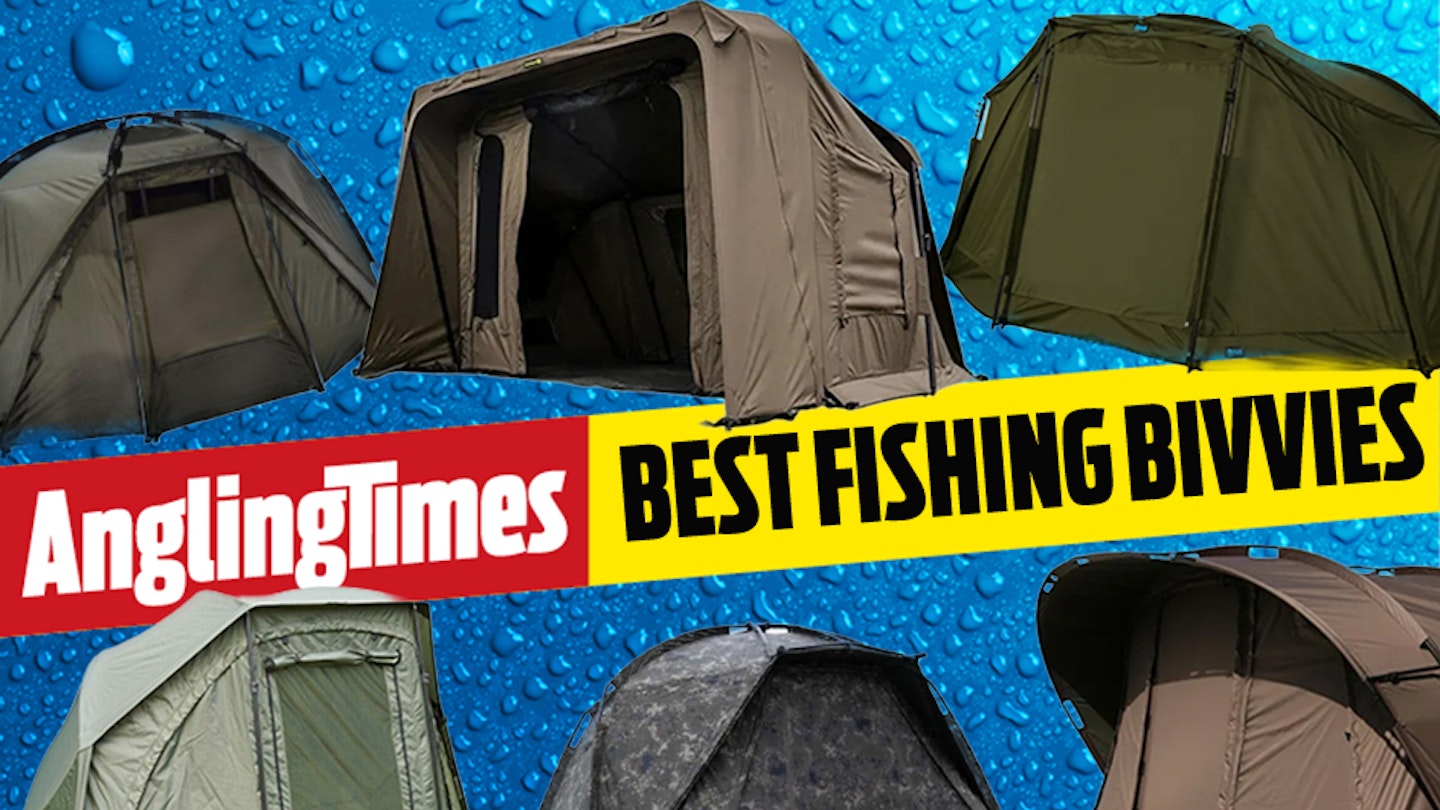For anglers who may be heading out carp fishing for long periods of time, a bivvy or shelter is an essential item of kit. Whilst we all might like the idea of roughing it under the stars when night fishing for carp, there's something also quite nice about setting up your own bankside home.
When it comes to shelters, the bivvy is by far the most popular choice for many anglers. They are solid, comfortable and offer maximum protection against the elements when set up correctly. If you are on limited time, however, a more traditional fishing umbrella-style shelter may be preferable.
When it comes to finding a bivvy for your angling, it can be a daunting prospect, with so many available from so many different manufacturers, it's difficult to know where to start. Is it just you fishing, or will family members/friends be joining you in the shelter? How much gear do you take, and how long do your sessions last on average? Do you fish in the colder months? All these things can dictate which shelter will be the best for you.
Best fishing bivvies at a glance:
You will spend a lot of time in your shelter during its lifetime, so getting it right can be crucial to how much enjoyment you get on the bank. The last thing you want is a heavy, complicated design which still fails to keep you dry and warm in the worst conditions. Here then, are our top picks of the best bivvies on the market currently...
How we test the best fishing bivvies

These fishing bivvies were tested by experienced members of the Angling times team. We have been using and abusing bivvies like these for decades and have probably used most, if not all of them during our time on the bank, so we know the best from the rest!
Tackle testers, Aidan Bordiuk, James Furness and Mark Sawyer have been testing a variety of bivvies on various waters, in all conditions imaginable, to ensure they deserve a place on this list! Whether you fish solely for carp, just enjoy night fishing with your family or need something that packs up quickly for overnighters, all the bivvies below have been thoroughly tested so we can give a rounded review!
Our decision process of what makes the best bivvies takes into account various factors including price point, weight, build quality, durability and usability to ensure we can give you the best advice on factors that will make an actual different to your angling.
The following list includes a mixture of our favourites for all types of angling you are likely to encounter! Find out how we test our gear, HERE.
Best Shelter (2024 National Angling Awards Winner)
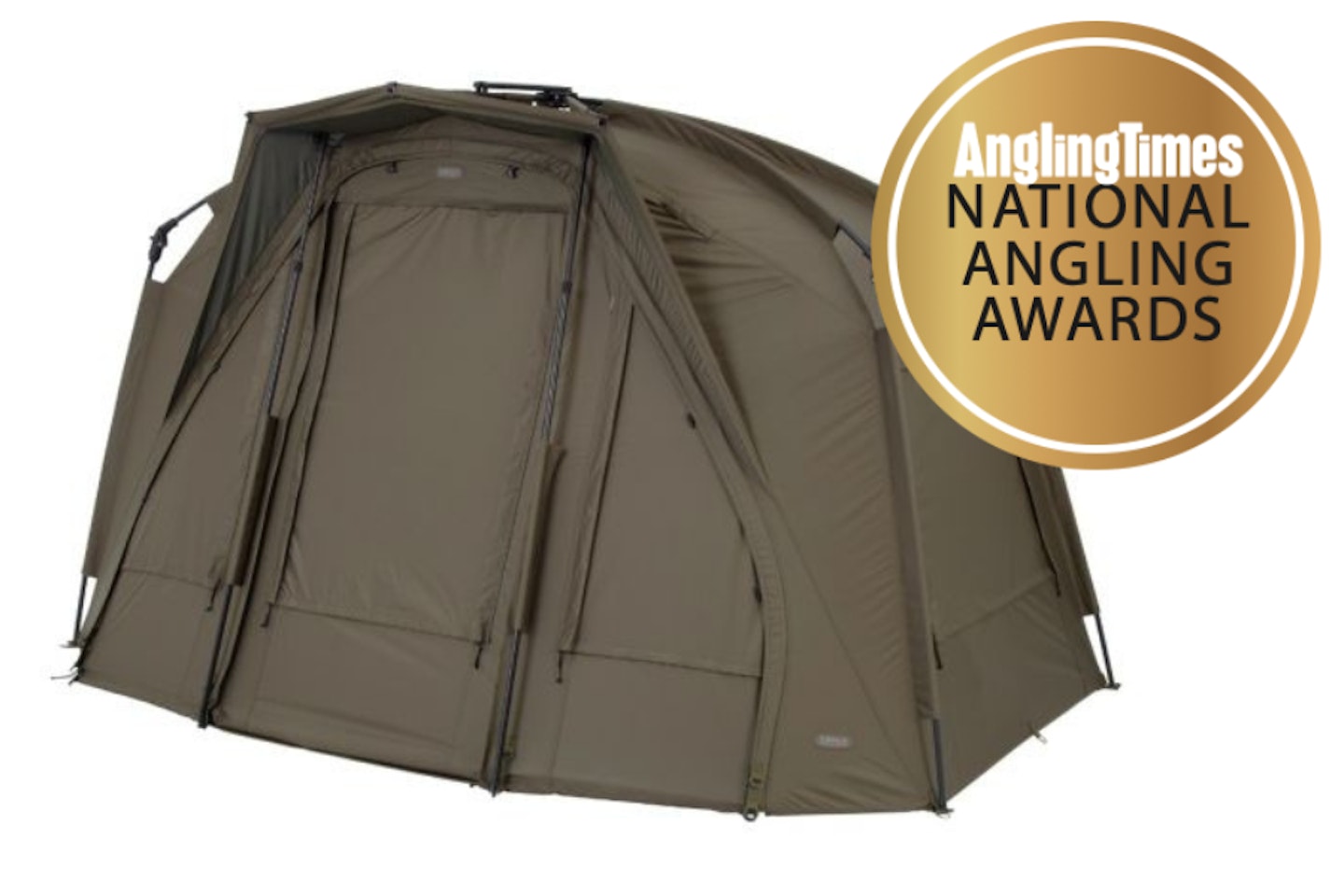
www.total-fishing-tackle.com
Trakker are renowned for their easy-to-erect shelters, and they have changed the game with their new Tempest RS 100 bivvy; it is simply unbelievable how quickly it can be put up.
Incorporating a newly designed hinge block and rapid knuckle system, the RS shelter can almost put itself up, and with practice, it can be erected in less than 10 seconds, superb for the mobile angler and those who really despise a shelter that is complicated to use.
Other features have been improved too, a flatter back enables you to utilise more space, allowing you to get away with a lighter, smaller bivvy than you might normally use. The Adaptive Ventilation Panels will help air to flow through the shelter to keep you cool, all of which are protected with mesh to prevent biting insects entering the bivvy. A 25,000 HH material enhances the durability and will make sure you stay dry, whatever the weather.
Four internal storage pockets have been included to allow the easy storage of items like valuables as well as a hanging loop for your receiver should you want to use it. The Rs 100, 150 or 200 versions are truly superb and well worth looking at if you're in the market for a new bivvy.
Pros
- Erect in less than 10 seconds.
- Superb design and quality build.
Cons
- Availability can be an issue, although it is improving.
Best newcomer shelter

www.total-fishing-tackle.com
The Fox Frontier Lite bivvy is basically a stripped-back ‘brolly-style’ version of the best-selling Fox Frontier bivvy. Designed with the mobile angler looking for a lightweight yet durable shelter very much in mind, It offers maximum protection and maximum space in a very compact footprint.
Weighing in at just 8kg, it is a lot lighter than the standard edition Frontier, yet still boasts a 10,000mm hydrostatic head. With many of the same features that made the original Fox Frontier shelters so popular, this bivvy is ideal for anglers looking for a high-quality option that doesn’t weigh a ton.
Also available is a solid front infill panel with a letter box-style removable door as well as a lightweight groundsheet which features clips to secure it in place.
Pros
- Lightweight at just 8kg.
- Perfect for short stay and overnighters.
Cons
- Groundsheet and door infill are sold separately.
Best In Class Bivvy

www.total-fishing-tackle.com
This innovative bivvy features a patented design that is both strong and easy to use. The 150 size is spacious, accommodating one bedchair with plenty of room for additional gear. The Aquatexx EV fabric offers exceptional breathability and waterproofing, keeping you comfortable in all weather conditions.
The durable construction features a machined aluminum block, ensuring long-lasting performance. Twin rear vents encourage airflow and reduce condensation, providing a comfortable interior environment. The bivvy comes with a removable infill panel, four Quicksticks, a clear window, T-pegs, and two erection poles.
The front of the bivvy can be removed, as can the back panels, to allow for improved views of the lake and better airflow in the warmer months. The shelter also comes with a 12-month warranty.
Pros
- Fantastic material and a solid construction.
- Long 12-month warranty.
Cons
- Skull cap available but not supplied, available seperatley
Best Bivvy to Erect
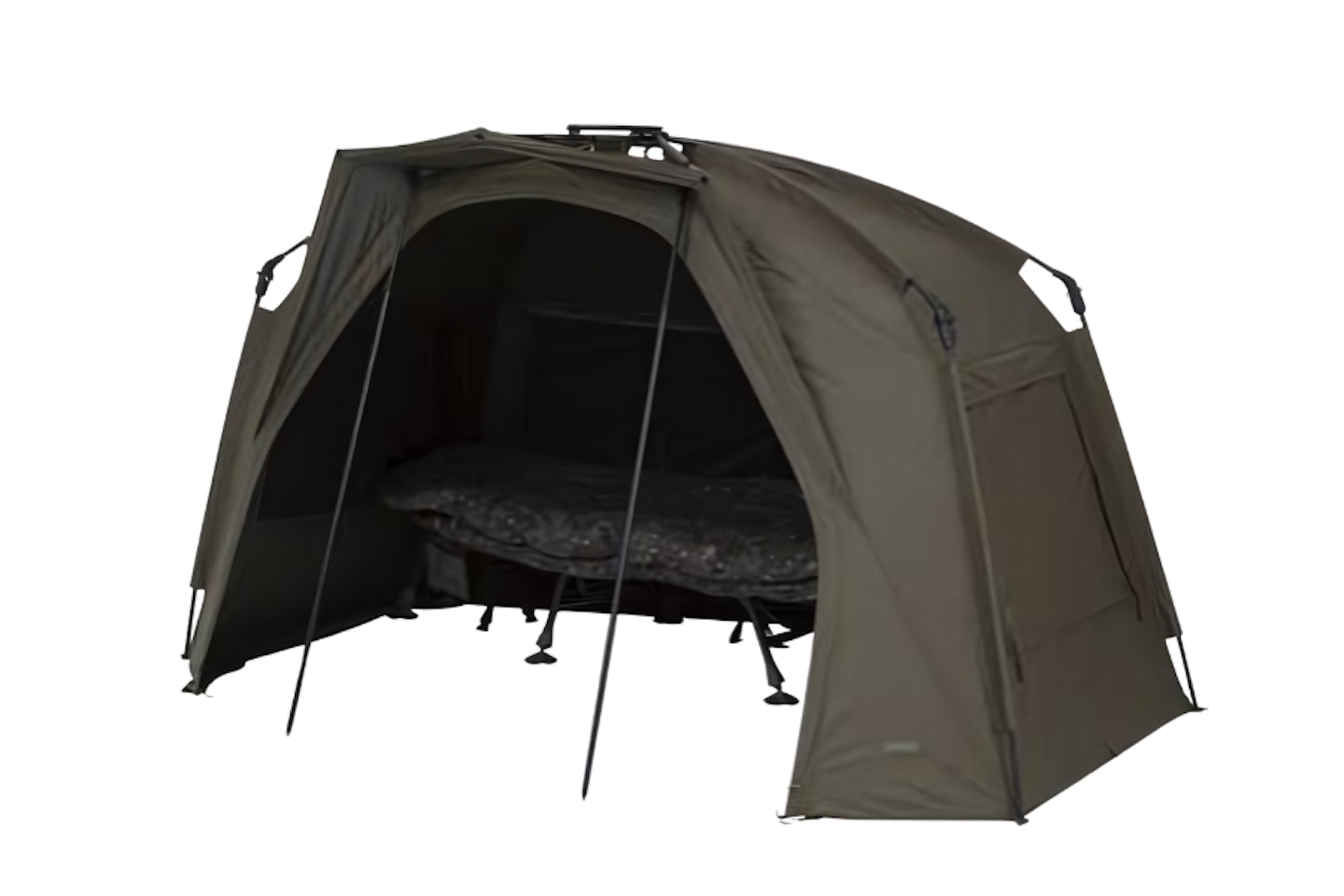
www.gooutdoors.co.uk
The original, fast-erecting bivvy with some new and exciting features. The Trakker Tempest 100 EV still holds the title for the quickest shelter to set up on the market.
This innovative bivvy features a revolutionary patented design that is incredibly quick and easy to assemble. The 100 size is spacious, accommodating one bedchair with ample storage space. Twin rear vents encourage airflow and reduce condensation, providing a comfortable interior environment.
Constructed from 210D polyester, the Tempest Brolly is waterproof and durable.
The advanced GRP composite block is lightweight and super-strong, ensuring long-lasting performance. The anti-twist pole system prevents the poles from twisting, providing a stable and secure structure. The Tempest Brolly is supplied in a 210D zipped carrybag, making it easy to transport from lake to lake. It also includes a tension strap and T-pegs for added convenience.
Pros
- 25000mm fabric, the most waterproof on the market.
- Still the fastest shelter to erect.
Cons
- No peak to divert driving rain away from the entrance.
Best Beginner Bivvy
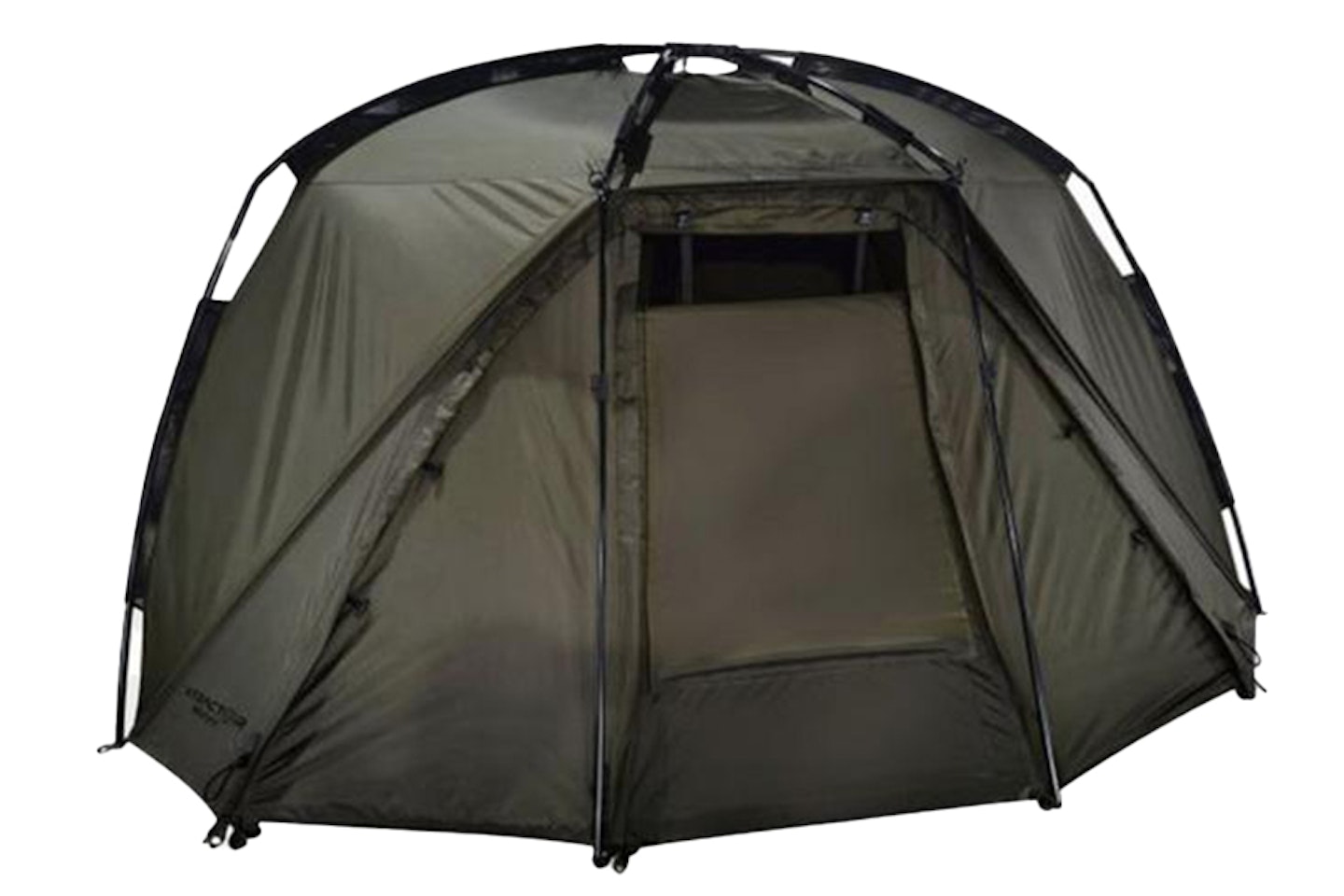
www.ebay.co.uk
Sonik have designed the Sonik Xtractor bivvy for anglers doing shorter sessions and overnighters by incorporating some interesting features. The bivvy sets up quickly, meaning you'll be fishing in no time.
The Xtractor's aluminium centre block streamlines the erection process completely. With all poles exiting the block, once the anti-twist ribs have been connected, the bivvy simply fans out and is locked in place under the peak at the front of the bivvy. This creates a very sturdy, freestanding structure that can be erected in as little as two minutes, perfect for those new to setting up a bivvy. The flat back, steep-sided design also helps maximise space, allowing the bedchair to be placed as far back as possible.
All the poles are made from strong aluminium, which helps to reduce the weight. Whilst the fabric incorporates a 5000mm hydrostatic polyester to ensure you stay dry. The bivvy also includes a Vapour cap to reduce condensation in the colder months, a big plus from us!
Pros
- Block system allows for easy and quick setup
- Flat back design gives plenty of internal space
Cons
- 5000mm fabric isn't as waterproof as others
Best Short Session Bivvy

www.fishingtackleandbait.co.uk
The Daiwa Mission Overnighter Plus is an ideal shelter for specimen anglers who fish a range of different venues, as its compact size and lightweight construction make it equally at home on lakes, rivers or canals. Upgrades from the popular Mission shelter have improved the quality and the ability to use the system for longer sessions too.
The front is now removable via the use of a zip, offering a more versatile shelter. If you're looking to fish for the day, but the weather looks miserable, you can just take the brolly section, helping to reduce the weight for those longer walks.
The tough 5000mm fabric will keep you dry and is durable enough to withstand the pressure the modern, roving approach can put it under. Storm poles and double-pegging points keep the shelter safe and secure on the most uneven banks.
Pros
- Lightweight package.
- Easy to erect.
Cons
- Fairly basic in terms of extras.
Best mid-range bivvy
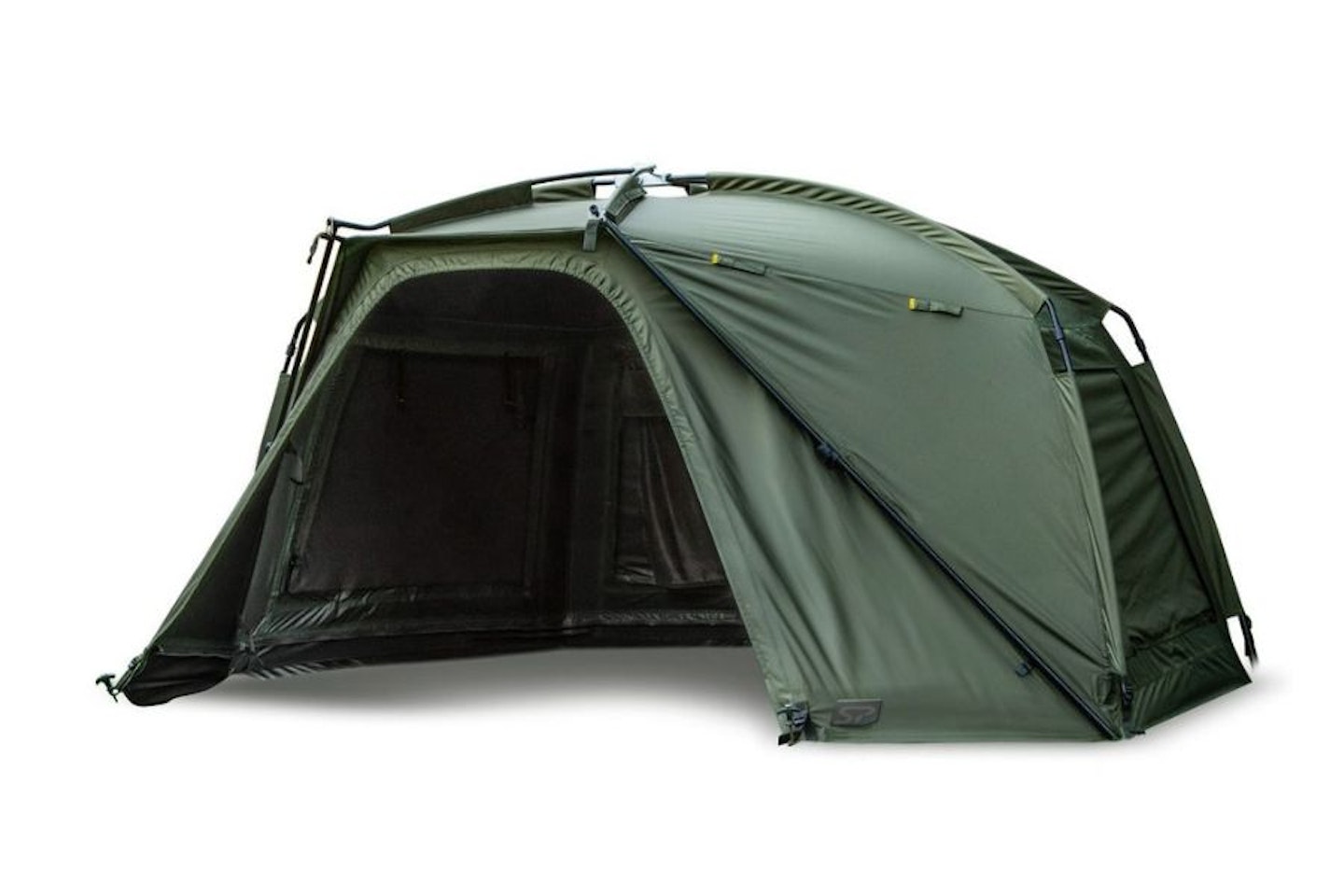
www.total-fishing-tackle.com
The Solar Tackle SP Uni Spider Bivvy is truly one of the best specification bivvies currently on the market, it has been designed to overcome every eventuality you are likely to face on the bank. The Spider Bivvy can be taken anywhere, for any duration in any season, thanks to its various features that make it as comfortable in 40-degree heat as they do in driving rain and minus temperatures.
The "Quick Up" frame allows the user to erect the bivvy in less than a minute, with the Spider arms fanning out and locking into place leaving a free standing shelter which doesn't need pegging down right away, great if it rains or you like to stay mobile. The square footprint achieves maximum internal space, allowing you to use the bivvy on longer sessions with no issues at all.
Internally there is a vapour shield to eliminate condensation and mesh pockets to the rear for storage of valuables or receivers. The back panels have a solid infill that covers a mozzy mesh infill, both of which are completely removable, depending on your preference. The Solar-Tex Material itself is durable and fully waterproof as well as having a blackout coating, if you like the inside to be really dark regardless of conditions outside, this is the bivvy for you.
Pros
- Can be erected in seconds.
- Packed with features.
Cons
- Zip in groundsheet sold separately.
Best Budget 2-Man Bivvy
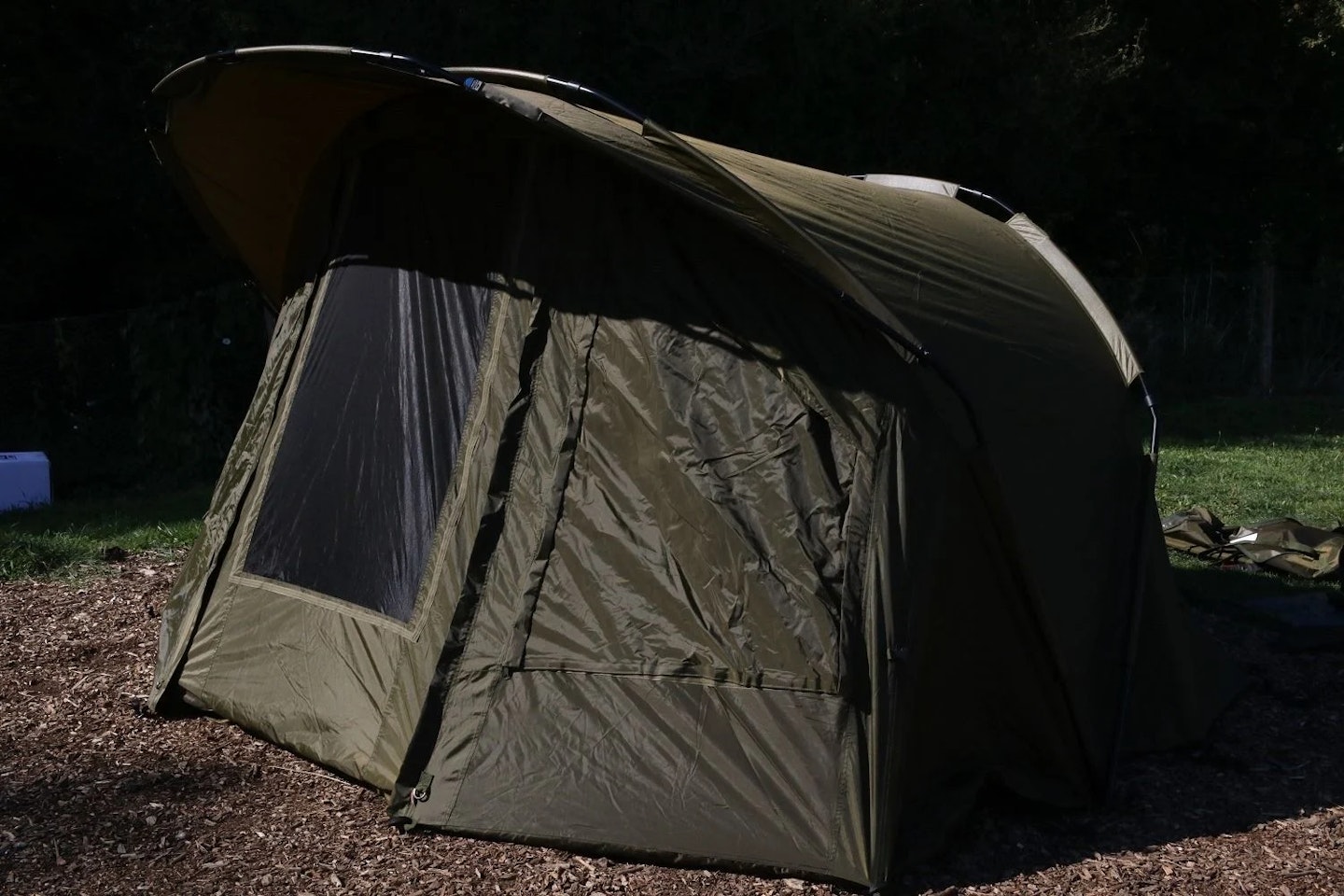
www.total-fishing-tackle.com
This spacious bivvy can comfortably accommodate two anglers with plenty of room for gear. The Fox EOS TT Pro 2 Man Bivvy is built with high-quality materials, it offers exceptional durability and weatherproofing.
Twin rear vents encourage airflow and reduce condensation, providing a comfortable interior environment. The Fox EOS TT Pro is easy to assemble and packs down conveniently for transportation. It can be used as a fully enclosed shelter or with the front rolled up for an open-fronted option. The bivvy comes with a groundsheet, carry bag, and other essential accessories.
Pros
- Large shelter, perfect for families.
- Great entry-level shelter.
Cons
- Can take a while to put together.
Best Hybrid Bivvy

www.total-fishing-tackle.com
Regarded as one of the strongest shelters on the market, the Nash Titan Hide Camo Pro is a great product for those looking for a fast erect, brolly/bivvy hybrid. With a whole host of extras that can be added, the Titan Hide Pro is as suited to overnight angling as it is to those fishing longer sessions. The flat back design allows a bedchair to be positioned against the rear of the shelter, ensuring the maximum space-to-footprint ratio is utilised.
The Hide uses a locking system, which gives the shelter its rigidity, eliminating the need for storm poles whilst also allowing the shelter to be freestanding. In swims that are difficult to get, pegs in this shelter will be invaluable. The anti-twist poles simply fit together, and the ribs are then fanned out and locked into place. We would say there aren't many faster bivvies to set up on the market.
An interesting and unique feature is the mesh capsule that simply clips to the Titan internally whilst being fused to a groundsheet, it eliminates insects and rodents from entering the bivvy. The 20,000mm fabric externally will keep you dry in any conditions.
Mesh organiser pockets are a welcome addition for storing items such as phones or receivers, this keeps everything neat, organised and to hand when needed, which can only promote more efficient angling.
Pros
- Strong, easy to erect.
- Very versatile bivvy.
Cons
- More suited to anglers that don't take loads of tackle due to its smaller footprint.
Best 2-Man Bivvy
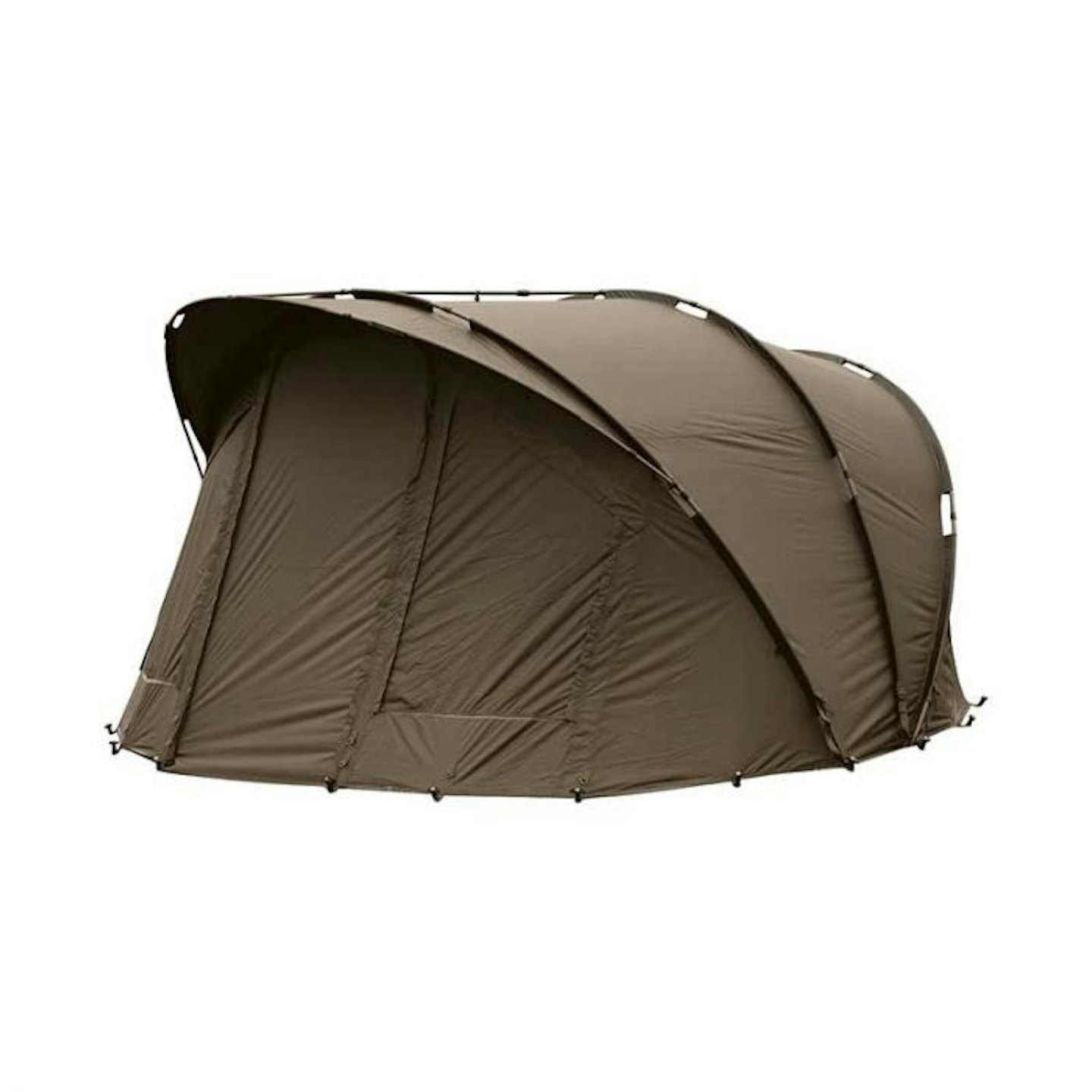
www.total-fishing-tackle.com
If you need a quality shelter with acres of room, then the Fox Voyager 2 Man Bivvy has you covered. Dimensions of 315cm Deep x 330cm Wide x 185cm High (6ft high) means that the average angler can stand upright in this bivvy with ease, and it is possible to fit three standard bedchairs in if required, perfect for a social or for taking your family fishing.
Structurally, the Fox Voyager Two Man is impeccable. It can be used in any condition thanks to its 10,000mm material and frame support bars. When combined with the tensioning strap, it makes for a very solid structure that will keep you dry and comfortable in most conditions.
Pros
- An enormous bivvy.
- Can accommodate three bedchairs.
Cons
- Can take a while to erect due to its size.
Best bivvy for long sessions
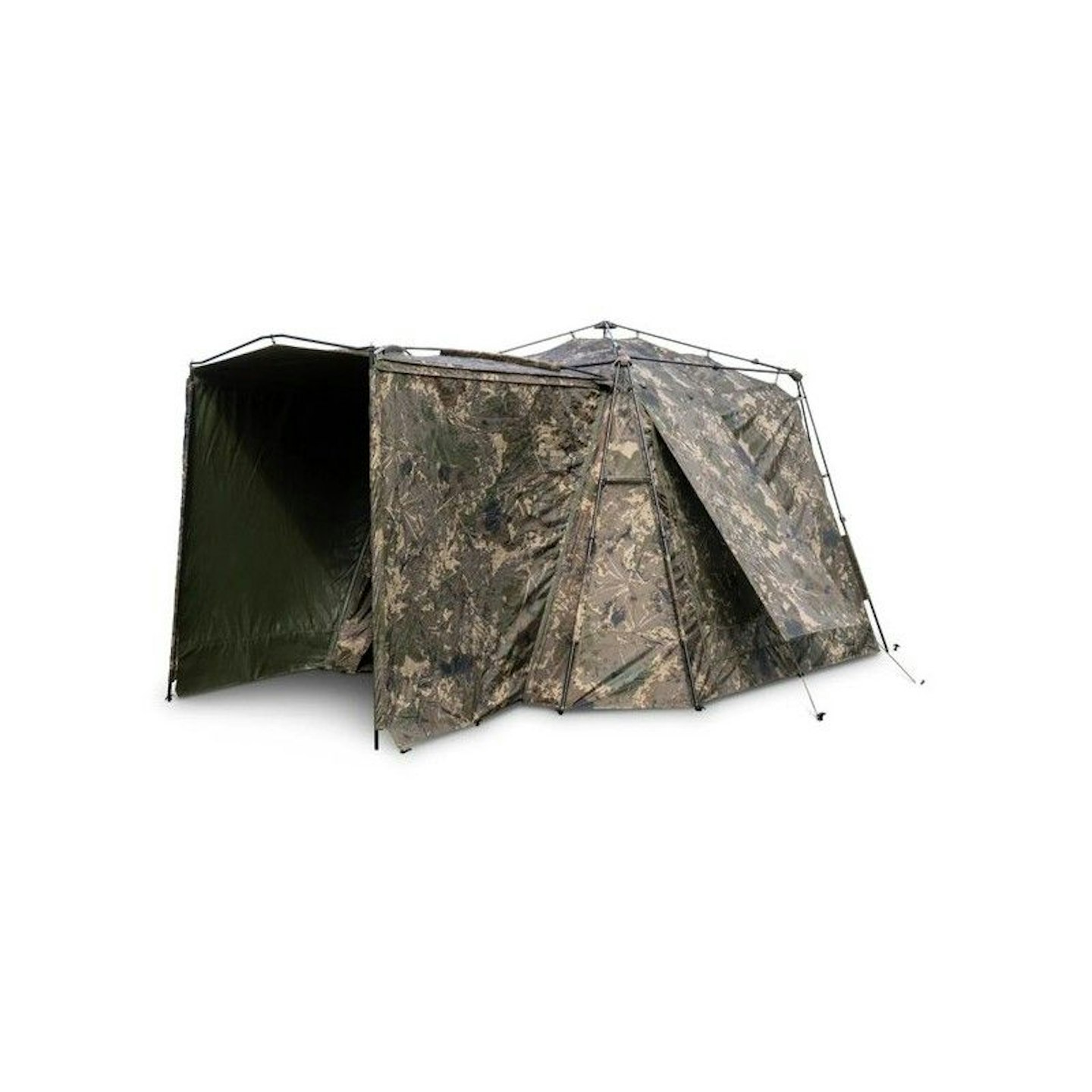
www.total-fishing-tackle.com
Up your fishing game with the Nash Bank Life Blockhouse Camo Pro Bivvy! It's the perfect shelter for those long fishing sessions, and it's not just any shelter. The Camo Pro specification offers different configurations to provide comfort, protection, and practicality, all in one.
With the 20,000mm Aquasense® waterproof fabric, the unpredictable weather won’t stand a chance. And for those who love their fishing even in the colder months, the optional T1211 Skull Cap (available separately), minimises condensation and keeps things cozy inside.
Featuring a storm porch. It's a full-height, framed front with independently zipped side panels. The door configurations are flexible too. And don't worry about getting stuffy in there. The enlarged panels provide excellent ventilation to keep things cool in warmer weather.
You can use this bivvy alone and easily fit an XL bedchair and the rest of your gear or remove the inner capsule and it's a 2 man bivvy with ample room to fit two bedchairs with room to spare.
The Nash Bank Life Blockhouse Bivvy is your all-season shelter. It's sturdy, spacious, and convenient. Whether you're facing tough weather or just enjoying a calm summer night by the water, you can count on it. After all, isn't fishing all about staying focused and enjoying the fishing?
Pros
- Fest erect frame makes set up quick and hassle free
- Features a full height storm porch
Cons
- Insulating skull cap is optional extra
What to look for in a bivvy
Picking the best fishing bivvy for you is largely determined by what type of angler you are. If you are a mobile angler, you want to look for a lightweight bivvy that you can erect quickly, allowing you to move and capitalise on any opportunity you may find. Conversely, if you do a lot of fishing abroad or fish for longer sessions, you may be far more comfortable in a larger bivvy that can store more tackle and people inside it.
If you fish a lot during the colder months, it is well worth spending more on a bivvy that has superior waterproof material and is renowned for its strength. A bivvy that has the option of an overwrap is essential to prevent condensation and keeps you much warmer too. All these things will make fishing far more pleasant during the miserable months.
Generally, the more you spend on a bivvy, the more waterproof and durable it will be. If you do a lot of angling throughout the course of a year, then a bivvy with thick, rip-resistant material will stand up to the demands you put on it.
Glossary
Bivvy: 'Bivvy' is an abbreviation of the word bivouac – an improvised campsite or temporary shelter.
Storm Pole: Thick, heavy-duty bank sticks that are screwed into the shelter to brace certain bivvies and brollies against wind.
Pegs: Robust metal spikes with heavy-duty moulded tops. Some pegs feature a spiral point for twisting the spike down into hard ground.
Pegging Points: Plastic or metal rings fused to the fabric provide somewhere to push a peg through to keep the shelter anchored to the floor.
Ribs: Long metal poles, generally with plastic fittings, that are used to brace a shelter and give it its structural strength and shape.
Hydrostatic Head: Hydrostatic head (HH) is a way of measuring how waterproof a piece of fabric is.
MM rating: Measured in millimetres (mm), this is a measure of how waterproof a fabric is. In the case of a 10,000mm fabric, if you put a cylinder with inner dimensions of 1" x 1" over a piece of said fabric, you could fill it with water to a height of 10,000 mm (10m) before water would begin to leak through. The higher the rating, the more waterproof it is.
Mozzy Mesh: An ultra-fine net which prevents insects from gaining access through it.
Bedchair: Foam mattress attached to a metal frame that is raised off the ground via legs. Provides somewhere to sleep when outdoors.
Groundsheet: A waterproof sheet of plastic or other durable material spread on the ground under a bedchair or in a tent for protection against moisture and mud.
Central Block: Usually constructed from metal or plastic, it is located at the top of a shelter and is where all the ribs extend from, without it, the shelter would fall apart.
Tensioning Strap: Length of fabric, sometimes elasticated with clips either end. The clips of the tension strap simply attach to either side of the bivvy and provide the exact level of tension required to maintain its structure.
Rain Gutter: Raised area of fabric at the front of the shelter opening, used to divert rainwater down the sides and prevent dripping/pooling of water at the entrance.
Letterbox: A way of setting the door panel to allow you to peer out at the lake without getting wet. Involves zipping the door up fully, then unzipping from the top to create a small opening.
Overwrap: Sheet of waterproof fabric that is designed to be positioned over the shelter for extra protection and to stop condensation forming inside.
Frequently asked questions
What is the best shelter for fishing?
With the diverse range of shelters available nowadays, it can seem like a bit of a minefield as to what shelter to choose. There is no one size fits all shelter, as all have pros and cons depending on the type of fishing you do. For the mobile angler that likes to move around, a quick erect bivvy or brolly system would be best. However, if you are a more stationary angler who likes to set up in a swim for the entire session and have a bit more comfort, then a larger bivvy would be far more suitable.
What is a fishing shelter and a bivvy?
Whilst both options provide a similar outcome, they do vary in construction, which may make one more suitable than the other.
Shelters are generally lighter and more compact in design. Typically designed around a brolly system to make them easy to erect, they tend to be targeted towards those who do short sessions and overnight angling.
Bivvies are built much more like a traditional tent, with fitted doors and a much more elaborate, stronger construction. The bivvy is more suited to the angler who requires more space and is generally doing longer sessions of 48 hours-plus. Bivvies provide space for the extra tackle and comfort for lengthier stays on the bank.
What is the best material?
With manufacturers offering their own version of the material with different names, it can be confusing to anyone as to what is best. We suggest ignoring the name of the material and looking at the HH rating (hydrostatic rating), with most providing a rating between 5000mm and 25,000mm. Put simply, the higher the rating, the more waterproof the fabric will be.
Obviously, we can't guarantee any material will stay waterproof, but if you are concerned, then we recommend going for the best material you can afford for more assurance.
What is included and what do I need to buy?
Depending on the manufacturer and the system you buy, what is included and what is available to customise it after can vary. The majority of bivvy systems will include a groundsheet, pegs, storm poles (if the design requires it) and a bag to carry it in. Quality does vary amongst suppliers, so do check if that's important to you. Then you can add different fronts, overwraps and skullcaps.
Brolly systems can vary, you can often just buy the shelter on its own and add items like fronts and mesh infills later, or they come as a complete system. It comes down to personal preference.
How much does a shelter cost?
The good thing about shelters is there is generally one that suits all budgets. Whether you have £100 or £1000 to spend, you can get something that will protect you on the bank. It goes without saying though, that the more you spend, the more features are included, and generally, the longer it will last.
Are fishing bivvies better than tents?
Yes they are, fishing bivvies are designed to be far more robust than tents and have the perfect amount of room to accommodate a bedchair and tackle. Very often they can be packed up and down in minutes making it easy to move around the lake, compared to a tent that can take much longer. They are windproof, waterproof and sunroof, often incorporating vents to keep you cool in the summer.
Do I need an overwrap for my fishing bivvy?
If you do a lot of fishing in the cooler months then we strongly advise getting an overwrap. This specially fitting sheet of material offers an extra layer of waterproofing to your shelter, while helping to trap air between the wrap and the bivvy. This layer of air insulates the bivvy and prevents condensation forming on the inside which would otherwise drip onto your bedchair making fishing uncomfortable.
Author Aidan Bordiuk is an enthusiastic angler who enjoys all fishing disciplines from match fishing to beach casting. He is currently occupying the position of Commercial Content Writer at Angling Times.
